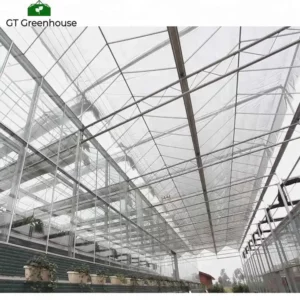Agricultural greenhouses contribute to resource efficiency in agriculture through various features and practices that optimize the use of key resources.
Here are ways in which greenhouses enhance resource efficiency:
- Water Conservation:
- Controlled irrigation systems in greenhouses allow for precise water management. Drip irrigation, hydroponic systems, and other technologies help minimize water wastage by delivering water directly to plant roots. Additionally, greenhouse designs can include rainwater harvesting systems to further reduce dependence on external water sources.
- Energy Efficiency:
- Greenhouses can be designed with energy-efficient features such as double-layered or insulated materials, automated climate control systems, and energy-efficient lighting. These measures contribute to lower energy consumption, especially in regions with extreme climates, where greenhouses provide a more controlled environment for plant growth.
- Optimized Temperature Control:
- Greenhouses enable precise control of temperature, humidity, and ventilation. This allows for optimal growing conditions, reducing the need for excessive heating or cooling. Well-insulated greenhouses also help retain heat, particularly during colder seasons, enhancing overall energy efficiency.
- Extended Growing Seasons:
- Greenhouses extend the growing season by providing a protected environment. This means that crops can be cultivated for longer durations, allowing for multiple harvests in a year. This helps maximize the use of land and resources throughout the year.
- Reduced Land Footprint:
- Greenhouses allow for vertical cultivation, optimizing space and reducing the overall land footprint required for agriculture. This is particularly beneficial in urban or densely populated areas where available land may be limited.
- Minimized Chemical Inputs:
- Controlled environments in greenhouses reduce the exposure of crops to external pests and diseases. China Agricultural Greenhouse supplier This can result in lower reliance on chemical pesticides and herbicides, contributing to healthier crops and minimizing environmental impacts.
- Enhanced Nutrient Management:
- Greenhouses facilitate precise control over nutrient delivery through hydroponic or other soilless cultivation methods. This targeted approach ensures that plants receive the necessary nutrients, minimizing waste and runoff of fertilizers into the surrounding environment.
- Optimal Light Utilization:
- Greenhouses can be equipped with supplemental lighting systems that provide the necessary light spectrum for plant growth. This ensures that plants receive consistent light levels, even during periods of low natural sunlight. Energy-efficient LED lights are commonly used for this purpose.
- Reduced Soil Erosion:
- Greenhouses often use container-based or soilless growing systems, minimizing soil erosion concerns. This helps preserve natural soils and prevents sediment runoff into water bodies.
- Localized Production:
- Greenhouses enable local food production, reducing the need for long-distance transportation of produce. This not only supports local economies but also reduces the environmental impact associated with transportation, such as fuel consumption and emissions.
- Optimized Plant Spacing:
- Controlled environments in greenhouses allow for precise spacing between plants. This optimizes the use of available space, prevents overcrowding, and ensures efficient resource utilization for each individual plant.
By incorporating these features and practices, agricultural greenhouses contribute to resource-efficient farming, promoting sustainability and resilience in the face of environmental challenges.
